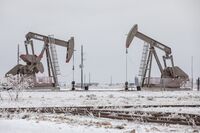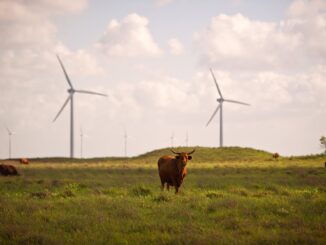
The energy crisis crippling Texas’s power system continued to spread, with nearly 5 million people across the U.S plunged into darkness as authorities fought to avoid a total collapse of the grid.
Homes and businesses from North Dakota to Texas are losing power in the middle of an unprecedented deep freeze that has broken daily temperature records in hundreds of places. The blackouts are likely to continue throughout Tuesday with no firm end in sight as the cold weather is forecast to remain through Wednesday.

Pump jacks in the snow in the Permian Basin in Midland, Texas.
Photographer: Matthew Busch/Bloomberg
Officials have reported two people dead, likely from cold, according to the AP news agency. Medical centers are rushing to administer vaccines before they go bad. Flights are grounded. More than a million barrels a day of oil and 10 billion cubic feet of gas production are shut while pipelines have declared force majeure and massive refineries have halted gasoline and diesel output. U.S.
President Joe Biden approved an emergency declaration for Texas, making more resources available to help.
“I’ve been following energy markets and grid issues for a while, and I cannot recall an extreme weather event that impacted such a large swath of the nation in this manner — the situation is critical,” said Neil Chatterjee, a member of the U.S. Federal Energy Regulatory Commission.
The cold blast is just the latest in a chain of severe weather events that have shaken power grids and upended energy markets globally from Japan to Pakistan and France in recent months. They’ve all underscored how vulnerable the world has become in the face of increasingly unpredictable weather brought on by climate change and it’s raising questions about the global push to electrify everything from transportation to heating and cooling.
WATCH: Millions of households in Texas are suffering rolling blackouts for the first time in a decade.
About 4 million homes and businesses were without power across Texas on Tuesday, based on utility outage data compiled by Poweroutage.us. Another 400,000 were down in a swathe of states stretching from Louisiana to Ohio and Virginia. About 250,000 were without power in Oregon.
In Mexico, over 4.7 million homes and businesses went dark after Texas’s shortages triggered cascading failures. But about 65% of those affected in Mexico had seen their power restored by midday, according to grid operator Cenace.
While temperatures are forecast to rise, the weather across the central U.S. will remain bitingly cold this week. Dallas, which was forecast to see a low of 2 degrees Fahrenheit (minus 17 degrees Celsius) late Monday, will reach a high of 29 by Wednesday, the National Weather Service said. But by late Thursday, readings will drop back into the teens.
Read More: ‘This Is Extremely Dangerous’: Texans in Peril at Home, on Road
Such drastic weather conditions are rare, especially in parts of Texas. In Houston, the state’s largest city, roads were iced over and people braved long lines to refill household propane canisters. Traffic and street lights are down. Firewood is selling out. Grocery stores have run out of essentials including milk.
This week’s cold front caught Texas’s highly decentralized electricity market especially by surprise. The region’s grid is designed for hot summers, not ice-cold winters. Utilities there haven’t had to carry out rolling blackouts since 2011.
Extreme weather events are happening more frequently, a shift that’s attributed to the changing climate. Policy makers globally acknowledge the need to reduce emissions in almost every aspect of human life. Electrifying sectors like transport and heating to use green power is seen as vital to reaching net zero but the world’s grid infrastructure may not be ready for that shift.
Burying power cables is an obvious way to protect them from severe heat or cold but it’s expensive and time-consuming and it’s not always possible. Networks need to find ways to strengthen their infrastructure to cope with wild temperatures and huge future increases in demand.
Traders are drawing comparisons between the energy shortages now gripping the central U.S. and the 2000-2001 energy crisis in the western U.S., as well as a 1998 run-up in power prices in the Midwest. Just months ago, California was forced to institute its first rolling blackouts in two decades when extreme heat pushed power demand beyond capacity.
Power plants with a combined capacity of more than 34 gigawatts were forced offline overnight, including nuclear reactors, coal and gas generators and wind farms, Dan Woodfin, a senior director for grid manager Electric Reliability Council of Texas said. It’s not yet clear why.
Read More: Texas Power Retailers in Face of Freeze: Please, Leave Us (1)
Wind power generators were among the victims of the cold weather, with turbine blades rendered inoperable due to ice — a phenomenon that reduces efficiency and can ultimately stop them from spinning. Texas estimated that more than half of its wind power capacity had come offline.
At times, parts of Texas were colder than Alaska, according to the National Weather Service. In the Dallas-Fort Worth area it was 5 degrees Fahrenheit. Houston may pick up as much as 2 inches (5 centimeters) of snow overnight, along with ice and sleet, the National Weather Service said. It will get hit by another storm bringing ice and freezing rain Wednesday.
“The southern plains are in a cold pattern,” said David Roth, a senior branch forecaster at the U.S. Weather Prediction Center. “It is going to take a while for them to break out of it.”
— With assistance by Brian Eckhouse, Dan Murtaugh, Aaron Clark, Stephen Stapczynski, and Amy Stillman -Bloomberg




1 Trackback / Pingback
Comments are closed.